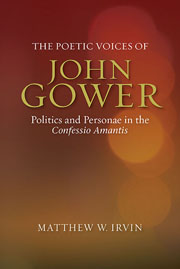Book contents
- Frontmatter
- Contents
- Dedication
- Acknowledgements
- List of Abbreviations
- Introduction: Making and Doing Love
- 1 The Inheritance of the Confessio Amantis
- 2 The Orientation of the Prologue to the Confessio Amantis
- 3 Amorous Persons
- 4 Pity and the Feminine
- 5 Labor and Art
- 6 Alienation and Value
- 7 The Love of Kings
- Conclusion: Identifying Amans
- Bibliography
- Index
- VOLUMES ALREADY PUBLISHED
2 - The Orientation of the Prologue to the Confessio Amantis
Published online by Cambridge University Press: 05 March 2014
- Frontmatter
- Contents
- Dedication
- Acknowledgements
- List of Abbreviations
- Introduction: Making and Doing Love
- 1 The Inheritance of the Confessio Amantis
- 2 The Orientation of the Prologue to the Confessio Amantis
- 3 Amorous Persons
- 4 Pity and the Feminine
- 5 Labor and Art
- 6 Alienation and Value
- 7 The Love of Kings
- Conclusion: Identifying Amans
- Bibliography
- Index
- VOLUMES ALREADY PUBLISHED
Summary
While Gower will develop a dialogue of fictional personae throughout much of the Confessio Amantis, in the Prologue, Gower appears to speak in propria persona, but in a voice similar to that of the vox populi. The Prologue also shares similar concerns with the sermones ad status in the Mirour and the Vox: the degeneration of the world, and the failure of the wise and prudent to understand the causes of that degeneration. For the first of these two problems there is no solution: Gower's favorite image, Nebuchadnezzar's Monster of Time, dominates the Prologue even in the illustrations, and, as Matthew McCabe points out, Gower goes further than most interpreters of it, claiming in the Prologue that the apocalyptic stone has already struck the statue. The second problem, however, can be solved, and it is to advising the wise and prudent that Gower dedicates the majority of the Prologue. John Fisher sees this political orientation of the Prologue to be “the chief continuity with Gower's previous poems.”
The intended audience is different for each of the three texts, however, and I will show how this changes the orientation of Gower's persona. The Confessio also has specific dedicatees, differing between the versions of the poems or “recensions” (the term used by G.C. Macaulay).
- Type
- Chapter
- Information
- The Poetic Voices of John GowerPolitics and Personae in the Confessio Amantis, pp. 46 - 73Publisher: Boydell & BrewerPrint publication year: 2014



